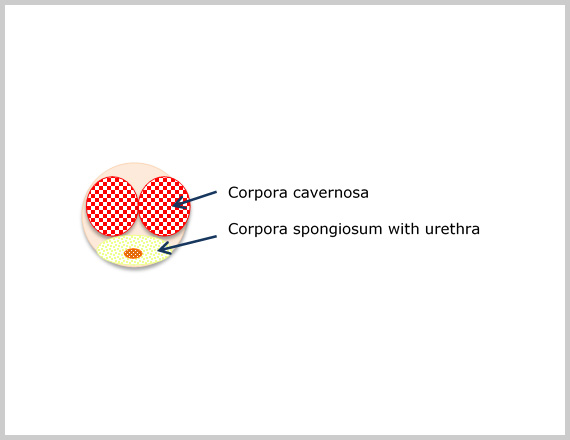What is erectile dysfunction?
Erectile dysfunction is the inability to achieve and/or maintain an erection, which is firm enough for sexual intercourse and the problem persists for more than 6 months. Around 15 to 25% of men aged 65yo have some form of dysfunction.
The degree of erectile dysfunction can be quantitated by the International index of erectile function (IIEF).

INTERNATIONAL INDEX OF ERECTILE FUNCTION (IIEF)
|
Over the past six months:
|
1 | 2 | 3 | 4 | 5 |
|
How do you rate your confidence that you could get and keep an erection? |
Very low |
Low |
Moderate |
High |
Very high |
|
When you had erections with sexual stimulation, how often were your erections hard enough for penetration? |
Almost never or never |
Much less than half the time |
About half the time |
Much more than half the time |
Almost always or always |
|
During sexual intercourse, how often were you able to maintain your erection after you had penetrated (entered) your partner? |
Almost never or never |
Much less than half the time |
About half the time |
Much more than half the time |
Almost always or always |
|
During sexual intercourse how difficult was it to maintain your erection to the completion of intercourse? |
Extremely difficult |
Very difficult |
Difficult |
Slightly difficult |
Not difficult |
|
When you attempted sexual intercourse, how often was it satisfactory for you?
|
Almost never or never |
Much less than half the time |
About half the time |
Much more than half the time |
Almost always or always |
|
IIEF-5 score is the sum of the questions 1 to 5. Lowest score is 5, highest score is 25.
|
|||||

How do erections work?
A penis is made up of three long cylinders. One cylinder (corpora spongiosum) contains the tube (urethra) which urine and semen passes down to exit the body. The other two cylinders contain a network of blood vessels important for an erection (corpora cavernosa).
Cross section of the penis
An erection occurs when the corpora cavernosa become engorged with blood. An erection requires a complex interaction of psychological, neural, vascular and endocrine factors often in association with sexual arousal. Sexual stimulation triggers the parasympathetic nerves of the autonomic nervous system, causing nitric oxide levels to rise in the arteries and smooth muscle of the penis. The arteries dilate causing the corpora cavernosa to fill with blood; simultaneously muscles around the penis compress the veins of the corpora cavernosa restricting the outflow of blood. The erection subsides when parasympathetic activity reduces to baseline.
An erection however is not entirely under conscious control. Erections can occur during sleep (nocturnal penile tumescence). Absence of nocturnal erection can help distinguish between physical and psychological impotence.
What causes erectile dysfunction?
Erectile dysfunction can occur when any of the factors involved in normal erections are disrupted (psychological, neural, vascular and endocrine).
It may be a symptom of another medical condition or may be the presenting symptom of an undiagnosed condition. The most common cause for impotence is atherosclerosis (peripheral vascular disease), a condition that causes the blood vessels to become clogged. Other common conditions associated with impotence include: High cholesterol, high blood pressure (hypertension), stress, anxiety, excessive alcohol intake, smoking, obesity, diabetes, neurological diseases and kidney disease. Work-up for erectile dysfunction therefore often includes investigations to exclude these conditions.
Erectile dysfunction can also be a side effect from medication. Common medications that cause erectile dysfunction include:
| Class | Examples |
| Antidepressants and other psychiatric medicines |
Diazepam (Valium) Doxepin (Deptran) Fluoxetine (Prozac) Imipramine (Tofranil) Lorazepam (Ativan) Nortriptyline (Allegron) Phenytoin (Dilantin) Sertraline (Zoloft) |
| Antihistamine |
Dimenhydrinate (Dramamine) Diphenhydramine (Benadryl) Ranitidine (Zantac) |
| Antihypertensives, cardiac and diuretics |
Digoxin (Lanoxin) Atenolol (Tenormin) Captopril (Capoten) Enalapril (Renitec) Furosemide (Lasix) Methyldopa (Aldomet) Metoprolol (Lopressor, Betaloc) Nifedipine (Adalat, Nyefax) Phenoxybenzamine (Dibenzyline) Prazosin (Minipress) Propranolol (Inderal) Spironolactone (Aldactone) Triamterene (Hydrene) Verapamil (Isoptin,veracaps) Carvedilol (Dilatrend, Dilasig) |
|
Hormonal medications
|
Antiandrogens (Cosudex, androcur, cyprone) Ketoconazole LHRH agonists (Lucrin, Zoladex) Finasteride (Finapen, proscar) Dutasteride (duodart, Avodart) |
| Over the counter medication |
Pseudoephedrine (Sudafed) Opiate analgesics (painkillers) Metoclopramide (Maxolon) |
| Recreational and illict drugs |
Alcohol Amphetamines Cocaine Marijuana Heroin Nicotine |
What treatments are available for erectile dysfunction?
Penile rehabilitation
The nerves for erectile function
The prostate is a gland that sits below the bladder. The urethra, a tube running from the bladder to the outside world, passes through the prostate. On either side of the prostate, attached to the prostatic capsule are the neurovascular bundles. The neurovascular bundle carries nerves that are important for erectile function.
Surgery can injury these nerves either permanently (neuropathy) or temporarily (neuropraxia). The most common cause of a nerve damage is following a radical prostatectomy. The extent of cancer dictates the ability to spare nerves. There are two neurovascular bundles so if the cancer is only on one side, the opposite side nerves may be spared. Even if the nerves are spared removing the prostate places unavoidable tension on the nerves. This results in the nerves being temporarily damaged (neuropraxia). It can take up to 2 years for the nerves to recover their function, and sometime full function may never return.


Penile Rehabilitation
While the nerves are dormant you loose daily and nocturnal erections that are important in maintaining healthy erectile tissue. These daily erections are important in ensuring flow of oxygenated blood to the tissue (called Corpora cavernosa). Without a regular supply of oxygenated blood, scar tissue develops (fibrosis). Overtime fibrosis reduces the ability of the corpora cavernosa to stretch when it become engorged with blood. This means loss o]f erections, even after the nerves recover.
Fortunately, there is now evidence that by using a combination of techniques to maintain blood flow to the corpora cavernosa, fibrosis can be prevented. Techniques include one or more of medication, vacuum pumps and injections.
What happens after rehabilitation?
It is important to know that only 5% of men will regain the same degree of erectile function after the operation as they had before. This is referred to as “returning to baseline”. Most men find their erections are reduced and more difficult to maintain after the operation. There is a significant chance you will need to continue with medication in order to obtain and maintain an erection. The rehabilitation program however will increase the quality of the erection and increase the chance of only requiring medication.
What if, after all this, I still can’t obtain an erection?
If you fail to achieve an adequate erection after one year, it is important to known there are other options. ‘Intra-cavernosal injections (ICI)’, involves using a very small needle to inject medication directly into the shaft of the penis that creates an erection. This is successful in the majority of men. Again, if you have been through the penile rehabilitation program, the quality of the erection, even of you subsequently require ICI, is improved. There is also evidence that penile length will be preserved.
Another alternative is a penile implant. There are two devices available. The most suitable one is an individual decision and should be discussed in person.
KEY POINTS
- Intimacy is an important part of life
- Rehabilitation is aimed at maintaining health erectile tissue while the nerves recover from the operation.
- Nerve recovery takes between 3 months and two years.
- Recovery of function is improved if you undertake rehabilitation
- If function does not spontaneously return there are more options available to assist in obtaining and maintaining an erection
